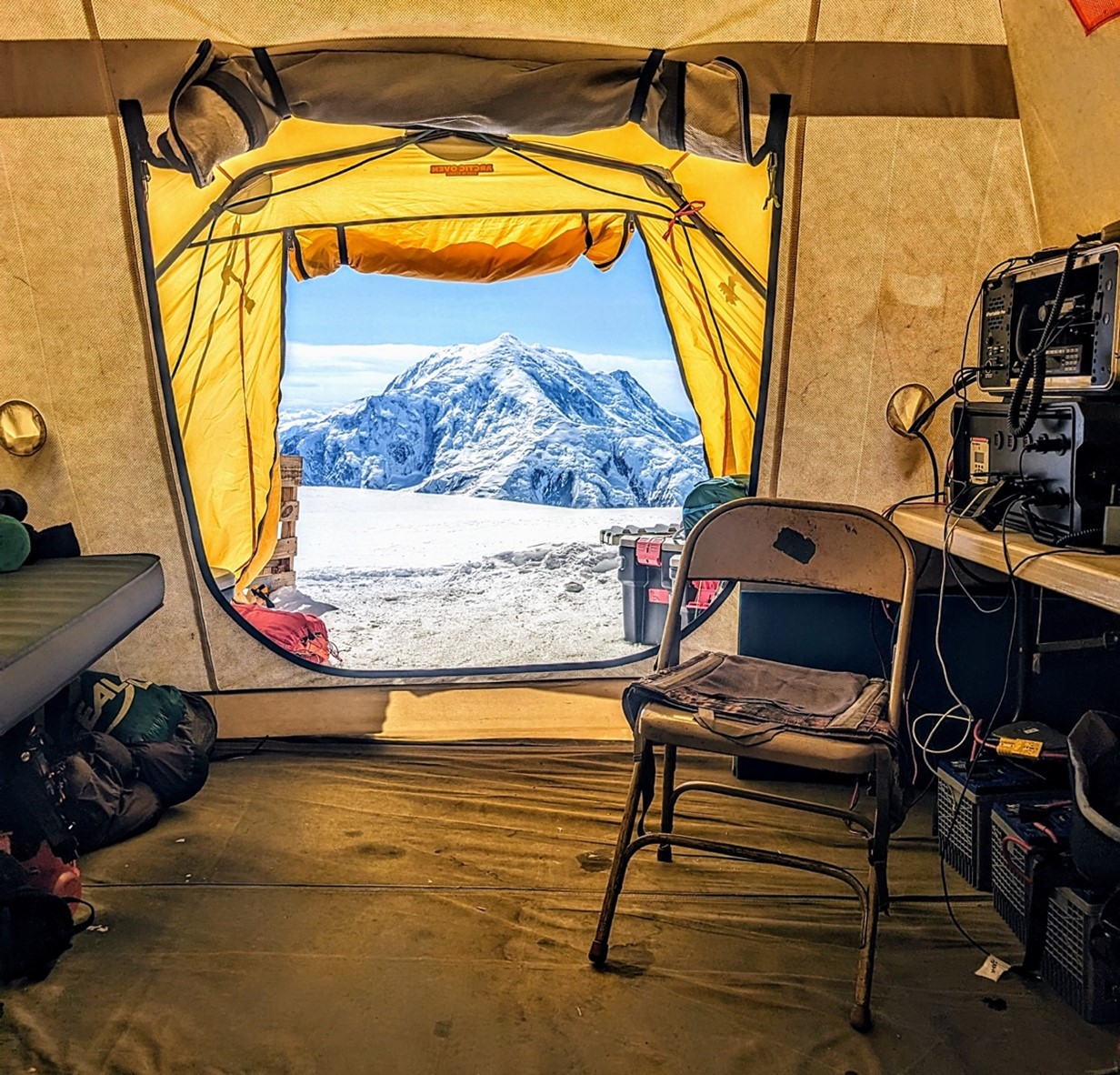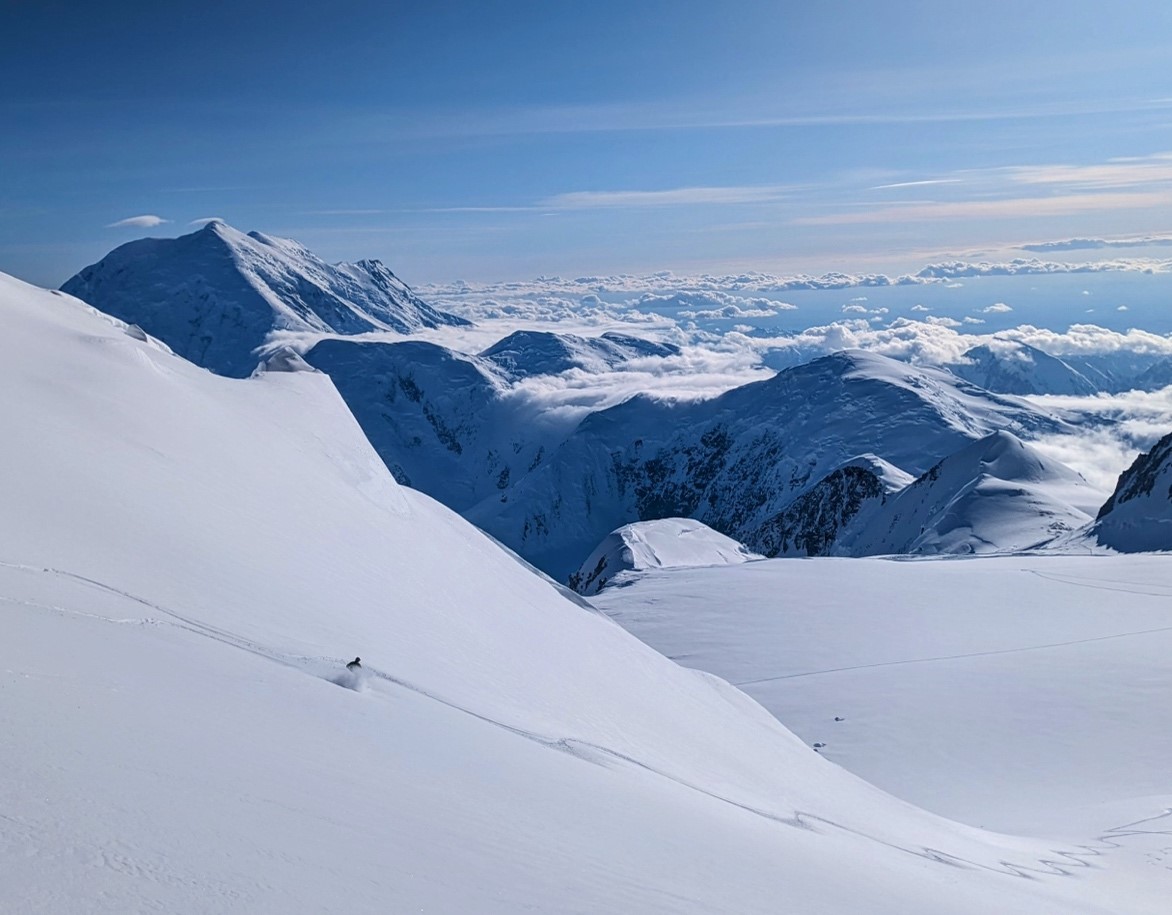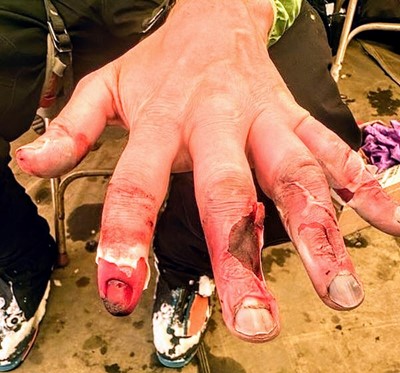 The Ranger Chair and Sultana. (NPS Photo/T. Baldwin)
The Ranger Chair and Sultana. (NPS Photo/T. Baldwin)
For those who come and wear the green and gray of the Park Service in Denali National Park, patrolling the upper reaches, there is a place that represents the essence of what it is to be a part of this team—the Ranger Chair. It has spanned all generations of mountaineering rangers and has co-existed with NPS operations on Denali for over 40 years. Its form has undoubtedly changed throughout its existence, but its function remains the same.
A very small number of rangers come to stay at the Walter Harper Ranger Station, whose careers are made and defined in these mountains. Their stories are of adventure, service, love, and loss. When the chips are down, and I look around the SAR room as we plan a rescue, experience matters. Mountain rescue is a nuanced act of balance between risk and reward, and the sliding scale is best operated by experience. Training, preparation, and checklists build proficient rescuers, but experience glues a plan together. Confidence in a plan can be underrated and is not something we quantify in the rescue planning stage, but it is directly correlated to the collective experience in the room. I am grateful to have these people nearby during difficult situations.
On the opposite end of the spectrum, some of us conform to the Park Service model of seasonal work and spend brief windows of time here. It’s a challenging model to build a proficient team with – each member should be skilled in technical alpine climbing, have a minimal medical qualification of a nationally registered EMT, have a strong foundation in technical rescue rigging systems (different than recreational climbing systems), be confident and proficient working around helicopters including short-haul experience, have a solid understanding of mountain weather systems, be able to lead a high altitude expeditions with 5 volunteers who don’t do this for a living, operate well within the team framework and perhaps most importantly, manage all the risks associated with the process. Now ask that person to commit to a 4 to 6-month season (often away from home and family with no travel stipend), receive little or no job benefits that last longer than the season, have to pay into government housing (perhaps subsidized or reasonably priced but still a cost) and then be cut loose to fill the rest of the year, often with the unofficial expectation that if you are hired into this coveted job, you will return to help build the team. If you are a National Park Service seasonal workforce supervisor and find an applicant with this combination of skill set and willingness to accept the circumstances, you struck employee gold.
The rest of us fall somewhere in between, returning for multiple seasons before moving on to other jobs. I have been continually impressed with the level of this team, challenges notwithstanding. My love and respect for the team members here are unmatched and grow with each season. The common thread stitching us all together weaves back and forth 5o miles across a rugged wilderness that separates the realities of life and work in Talkeetna from the undeniable pull of the Alaska Range.
And right smack in the middle of it all lies the Ranger Chair.
The West Buttress operation starts in late April when the first Park Service patrol flies to base camp. This team anxiously leaves base camp with the singular goal of getting to 14,200’ and setting up the Park Service infrastructure. This is the most challenging patrol of the season. It’s cold and windy, and the workload of building camp that awaits this ranger team high on the mountain can be intimidating. The team make-up is often 4-5 Denali Rescue Volunteers accompanying a Park Service ranger. Around this same time, over 6000 pounds of gear gets moved in stages from Talkeetna to 14,200 feet. The park-contracted helicopter does the heavy lifting, slinging net loads upwards of 800 lbs to the pre-determined camp location. This gear is essential to our operation – tents, medical supplies, oxygen bottles, communications, rescue gear, food, stoves, propane, batteries, solar panels, antennas, cables, and more. And buried somewhere amongst the sling load piles is the Ranger Chair.
The Chair is a standard metal folding chair—perhaps not ideal for a cold winter environment. Anyone who has spent time in this chair will instinctively reach for one of several seat cushions in the communications tent to insulate and reduce the conductive heat loss that will otherwise quickly remind you of where you are.
As another Denali climbing season winds down, I reflect on the perspective I received from the Chair. Everything that happens on Denali goes through the ranger in the Chair. Whether it is a patient evacuation at 14k camp, a frostbite call at 17k, an InReach SOS activation at Windy Corner, a ranger team checking in from the Football Field, or a gear resupply, it will go through the Ranger sitting here. It’s not a seat of control but one that allows for awareness. The Chair is naturally positioned in front of a folding leg table, supporting all things communication. The table supports two radio base stations with remote microphones. One is the NPS VHF radio that all park operations run through, and the other is the FRS radio, a UHF radio band used by climbers and guides. Under the radio sits the mobile electronics box collectively referred to by rangers as the “brain.” It houses a solar controller and several 15 amp DC circuits that power auxiliary charging, radios, and other accessories. The table is often littered with NPS and personal satellite messengers in various states of charge and the cell phones tied to these devices. SpaceX's Starlink system is the most recent addition to the table and arguably the most useful, bringing mobile broadband capability to our search and rescue operations. Half a dozen 12-volt deep cycle car batteries wired in parallel fill the space under the table and power the operation.
All rescues on the West Buttress are coordinated from here, though the Incident Commander (IC) will ultimately be in Talkeetna. Still, we operate fluidly within the Incident Command System and know from experience that operations and on-the-fly planning happen in the field, often at 14k. As a result, the occupant of the Chair is well-informed of the current situation on the West Buttress. In any given season, roughly ten rangers will cycle through this seat.
Anyone who has worked in emergency response can tell you about the random nature of calls. It’s no different on the West Buttress. When it gets busy, our team works nonstop and may be up through the night cycling patient care duties or checking the weather, looking for flyable conditions for our helicopter. The crack of the radio is constant during these times of high call volume. The Chair becomes a hot seat of information exchange and planning - patient reports, evacuation considerations, team location updates, and resupply needs. Fatigue can catch up quickly with minimal personnel, and managing the limited resources and rescuers becomes a priority. During lulls, you catch up on rest or get out for a ski lap to enjoy the tremendous surroundings. Slow evenings will often find the team gathered around the Chair, playing games, listening to music, or debriefing the day. Stress fluctuates with call type and volume and is managed accordingly.
 A skier descending to 14,200-foot camp. (NPS Photo/T. Baldwin)
A skier descending to 14,200-foot camp. (NPS Photo/T. Baldwin)
Frostbite cases continue to dominate our workload. My perspective on this specific problem, gained from time spent in the Chair, has evolved to include some frustration. Roughly half of our patients suffer from altitude illness or cold injury. This breakdown fluctuates slightly from season to season but remains valid. tPA (tissue plasminogen activator) has been a standard treatment at hospitals for frostbite patients since the 1990s. It can help counter the effects of cold-induced thrombosis (decreased blood flow), ultimately reducing the chance or extent of tissue amputation. The challenge with effective treatment lies in the time-sensitive nature of receiving care. tPA is most effective when received within 24 hours of tissue thawing, a challenging timeframe when factoring in an evacuation off Denali, notorious for bad weather and consecutive days of unflyable weather. As of February 2024, Iloprost was approved by the FDA for the treatment of frostbite. While this drug has also been around for some time, targeting pulmonary arterial hypertension, its efficacy for treating frostbite through similar pathophysiology to tPA is becoming more widespread – or perhaps more accurately, it is becoming officially acceptable. The bonus with Iloprost is that studies have shown its effectiveness several days after frozen tissue has been thawed, increasing the critical treatment timeframe for frostbite patients. Regardless of the treatment, the clock starts ticking when we fire up the hot water baths to thaw the tissue, and the pressure to evacuate the patient slowly builds. That pressure is tangible when sitting in the Chair and looking for the next flyable weather window.
 Frostbite Damage. (NPS Photo/C. Oken)
Frostbite Damage. (NPS Photo/C. Oken)
From a medical perspective, many treatments are time-sensitive, especially with patients who meet our evacuation criteria with threats to life, limb, or eyesight. The difference between some of these other serious emergencies is that frostbite cases are almost 100% avoidable. (And for those playing the Devil’s advocate, I do not entertain the notion that all injuries on Denali are avoidable simply because the choice is made to undertake this endeavor and could, therefore, be avoided if we chose not to go. I am also not of the opinion that all accidents are avoidable.) Almost every frostbite case I can think of in the last seven seasons resulted from poor decision-making. This is my subjective opinion, but when a climber prioritizes an objective over their health, I can’t help but question their priorities. I shouldn’t judge one’s decision-making or question one’s priorities, but when the outcome of an avoidable poor decision forces me to enact a rescue that elevates the risk exposure to my team, I can’t help it. To be very clear, the avoidable poor decision that I am explicitly referring to is continuing to go up the mountain when you can’t feel your fingers or toes and neglecting to stop and fix the problem. The West Buttress of Denali is not a committing technical alpine climb. At almost any point, you can stop to deal with a problem or turn around and walk back to camp.
As a team, we do our best and take pride in providing the best medical care we can, despite the remote location and limited resources. If a threat exists to someone’s life or limb (fingers and toes included), we will do our best to evacuate the patient as quickly as possible. When there is a ticking clock dictated by the treatment protocol, we feel the pressure. Our risk management process kicks in with every rescue, and the amount of risk we accept hinges on several factors, including what can be gained (or, in this case, saved). While we don’t accept unnecessary risk for our team, that metric is hard to quantify, and every time the A-Star lifts off the pad, risk exposure is elevated. Accessing patients above 14,000 feet increases the exposure due to the challenges of mountain flying and the rescue techniques involved. Flyable weather thresholds are sometimes pushed, and accessing patients on the ground in harsh conditions is difficult. I’m grateful for the skill and poise of our pilots. Nonetheless, sitting in the Chair during times of elevated risk while coordinating these rescues can be hard. Knowing that we’re dealing with someone’s preventable problem makes it worse. Perhaps a reclining option and built-in cushion would ease the burden.
Unfortunately, I don’t believe there is a simple solution to the decision-making process. During our pre-climb briefing with every climber, we stress several PSAR (Preventative Search and Rescue) topics, including strategies to help prevent frostbite. Part of the problem lies in the lack of understanding and/or acceptance of the consequences, which I have written on previously. Combined with an objective-driven mindset (not always a bad thing) and some frigidly cold temperatures, the recipe for frostbite will always be there. I spoke with many climbers this season both on the mountain and during check-outs at the Ranger Station who made excellent decisions throughout their climbs. These climbers chose to only go up when conditions were appropriate (many of whom had successful summits), to turn around when necessary, or to adjust plans based on any number of factors in front of them. These decisions are not always straightforward, especially for less experienced mountaineers, and as a team, we made a point to applaud and recognize these successes. As climbers, we spend so much time and energy improving our technical skills, refining gear, and planning these adventures that it’s easy to overlook the importance of experience gained from mentorship and mileage. If only there were a decision-making guidebook. I would title it When Your Fingers Get Cold, Stop and Rewarm.
It will never cease to amaze me the number of times I hear from frostbitten climbers saying that it was all worth it to get to the summit while staring down at his black, dead finger tissue. In the weeks following a severe frostbite case, the affected tissue will necrose, leaving a distinct demarcation between live and dead tissue that the surgeon will use as a guide for amputation. Did he understand the consequences? Or has he just not accepted reality yet? The worst tragedies are those that are preventable.
From inside the Comms tent on a clear day, Sultana fills the entrance. If you lean back in the Chair just a little and look to the left out the door, the vastness of the Alaska Range spills in. It’s a unique perspective, and one that has shaped my career. This week marks the end of the NPS season on the West Buttress. The last patrol is packing camp, and the reverse process of slinging gear loads back down to base camp has begun. One of those loads contains the Chair, packed away with other odds and ends from the Comms tent, soon to be put away in storage for the next nine months. It’s just an ordinary folding metal chair.
